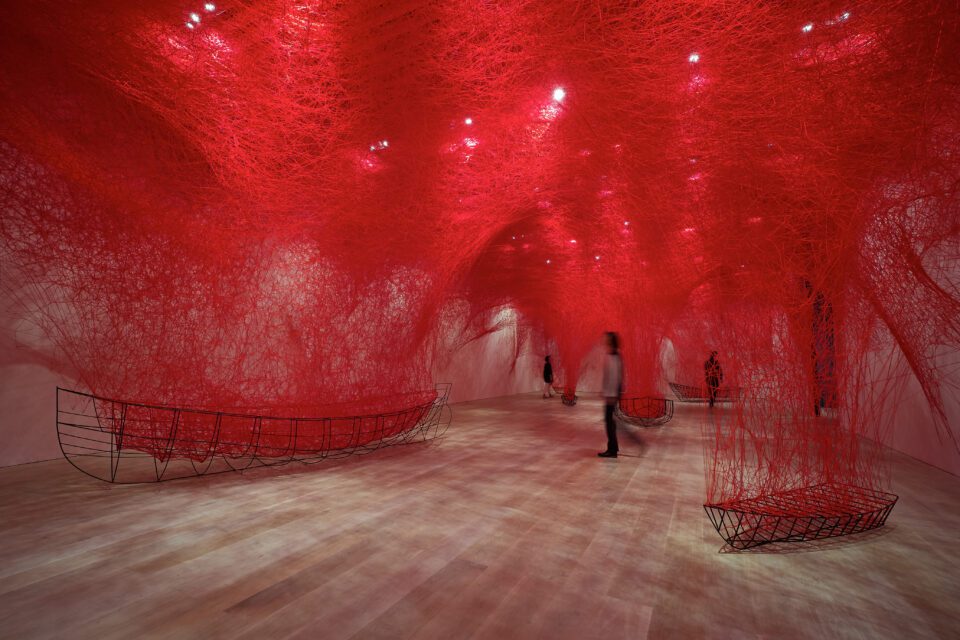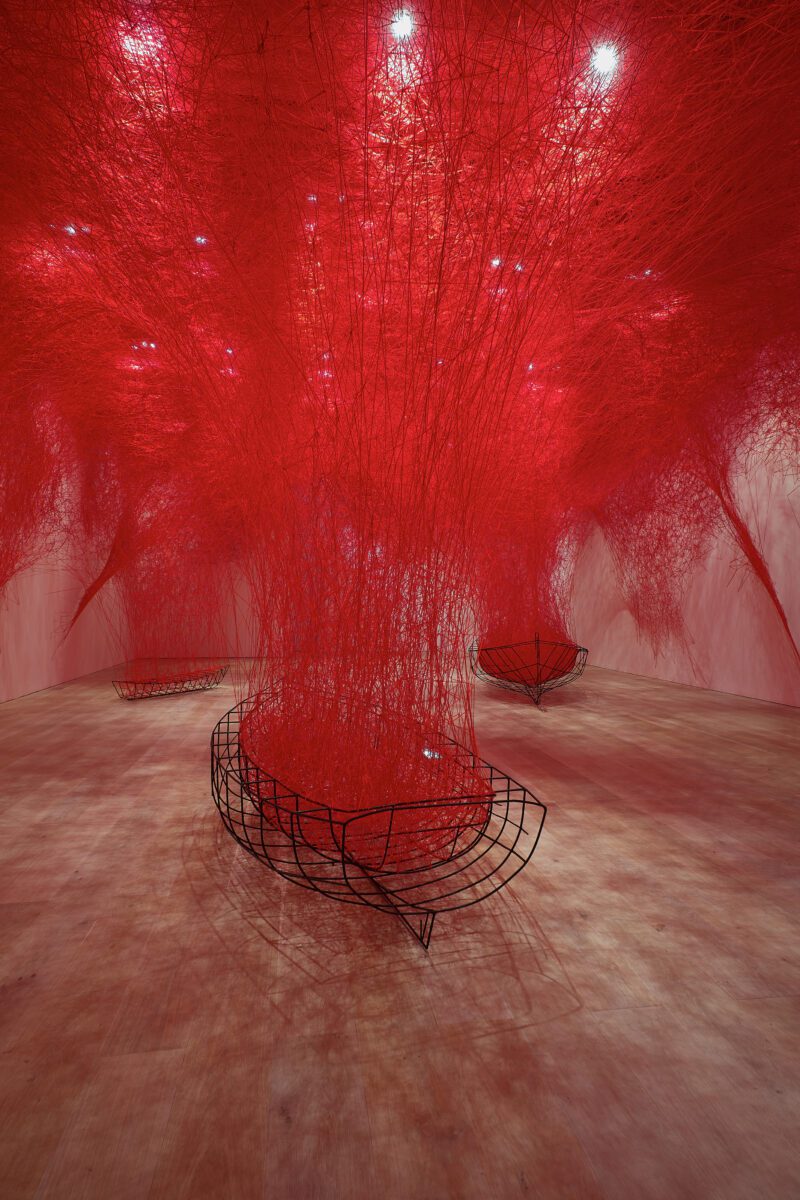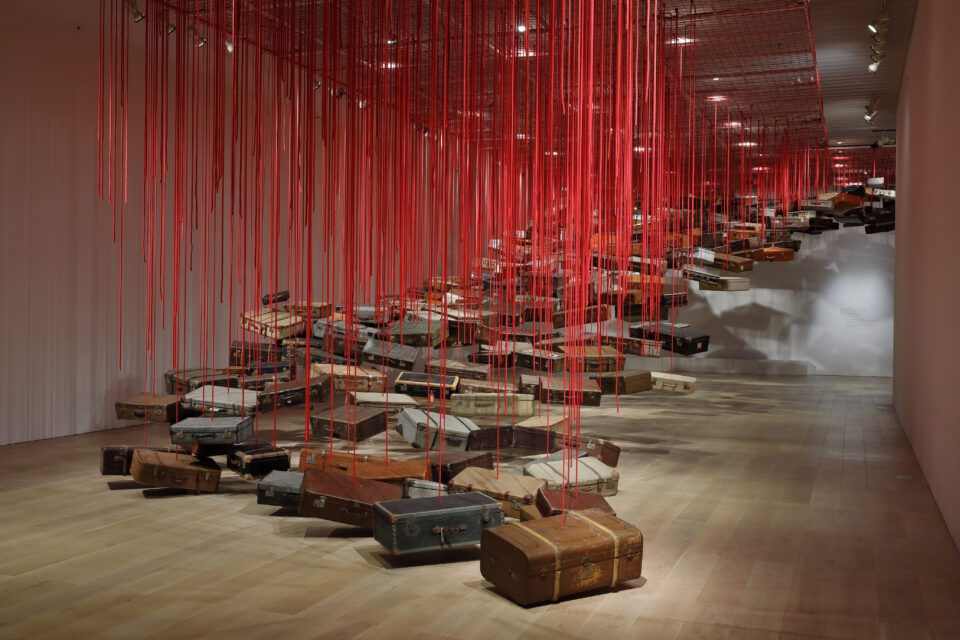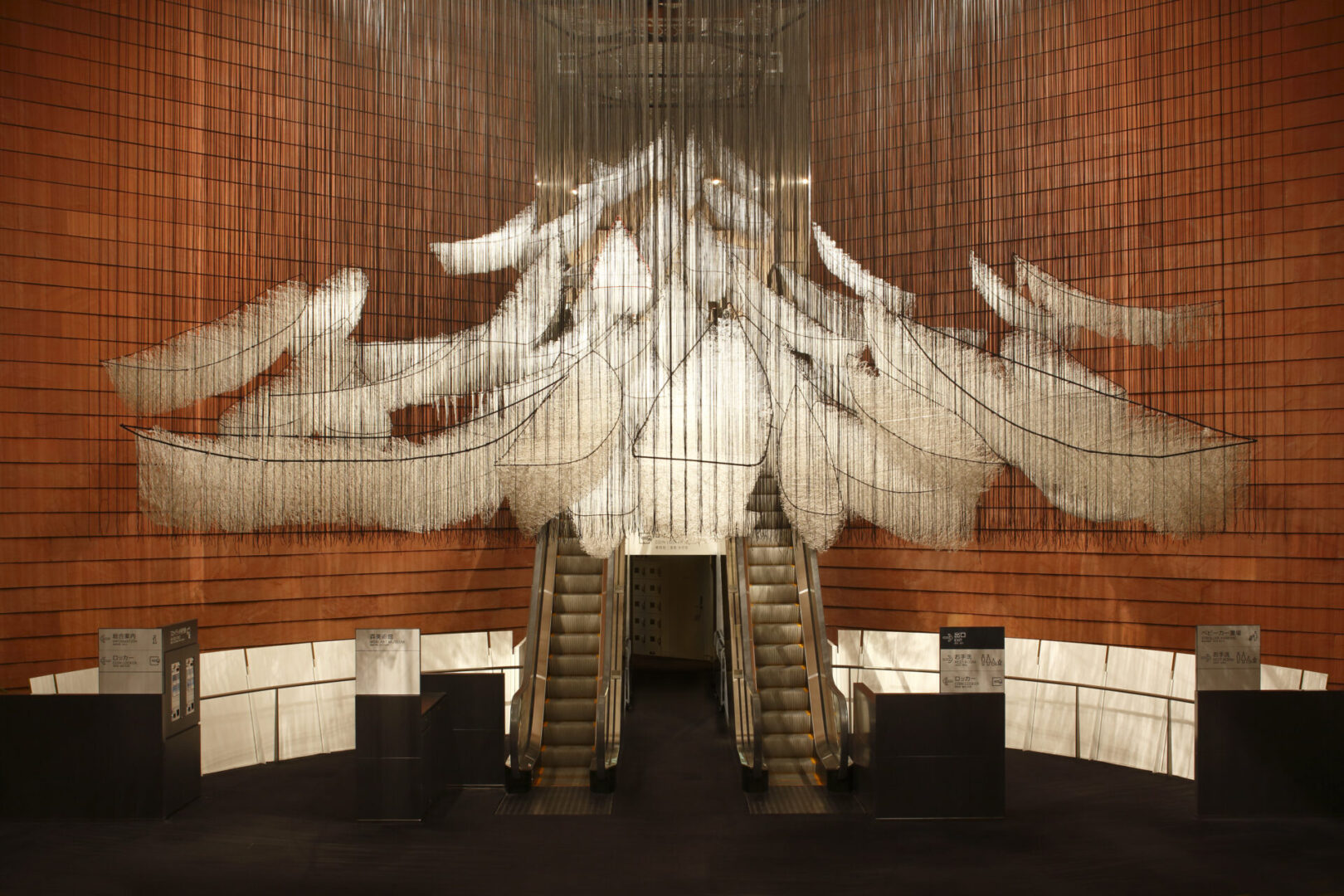Chiharu Shiota’s work fills the galleries of MAO Museo d’Arte Orientale in Turin with a sense of presence and reflection. The Soul Trembles, curated by Mami Kataoka and Davide Quadrio, traces over 20 years of the Japanese artist’s practice, bringing together drawings, sculptures, photographs and monumental installations. Her pieces transform the museum into an immersive environment where threads, boats, dresses and suitcases act as carriers of memory, identity and human experience. The exhibition places Shiota’s work in dialogue with MAO’s collection, inviting visitors to consider the connections between East and West, past and present, and the visible and invisible traces that shape our lives. It is an exhibition that asks viewers to engage fully with the emotional and conceptual weight of each installation.
The exhibition opens with Where Are We Going? (2017), a suspended flotilla of boats entwined in black threads, evoking uncertain journeys and human vulnerability. Boats appear throughout Shiota’s work as literal vessels and metaphors for passage, loss and hope, inviting viewers to negotiate a space that feels both delicate and precarious. Movement and stillness coexist, uncertainty pulses and memory is rendered material. In an era marked by migration, geopolitical upheaval and social flux the installation resonates beyond the museum walls, reflecting the fragility of existence and the invisible connections that bind lives across continents. Shiota’s boats are not merely objects but carriers of emotion, tracing human experiences across temporal and spatial divides, transforming the gallery into a liminal space of encounter.

Uncertain Journey (2016/2019) intensifies this exploration of human fragility and connection. Red yarn wraps skeletal ships creating a vivid lattice of encounters, departures and arrivals. Each thread becomes a conduit for memory, each vessel a repository of stories, histories and emotions that are otherwise unspoken. The vibrancy of the red animates the gallery with tension and intimacy, inviting viewers to consider the complexity of human encounters and the ephemeral yet profound impact of every meeting. In a global context where displacement and uncertainty are constant, Shiota’s work resonates as an elegy to the impermanent yet persistent threads that link people across distance, culture and time.
Silence takes physical form in In Silence (2008), where a burnt piano and rows of phantom seating entangled in black threads evoke the stillness that follows destruction, the lingering echoes of trauma and the quiet persistence of memory. Absence becomes a palpable presence, a meditation rather than spectacle, inviting reflection on grief, loss and endurance. The work resonates in contemporary times, when societies are scarred by conflict, disaster and upheaval, reminding viewers that resilience often grows in the quietest spaces, that memory can be preserved in the shadows and that the intangible can gain weight. Shiota transforms emptiness into narrative, allowing silence to tell its own story.

Reflection of Space and Time (2018) presents a dress and its mirrored double, meditating on presence and absence, corporeality and temporality. Visitors confront an echo of the self, a fragment of identity refracted and multiplied, a meditation on the traces left behind in human life. Inside–Outside (2009) explores dichotomies of public and private, East and West, interior and exterior, underscoring the porous boundaries of perception and cultural memory. Shiota’s work is performative in essence, demanding engagement with space, material and thought, inviting viewers to pause and inhabit its intricacies. Each piece is an exercise in presence, where memory, emotion and reflection become as tangible as thread.
The exhibition reaches monumental scale with Accumulation – Searching for the Destination (2021). Hundreds of suspended suitcases oscillate like a forest of memories in motion, symbolizing migration, personal history and the archetypal journey each of us undertakes. Objects ordinary in appearance become repositories of narrative and experience, capturing both individual and collective movement. In a world where mobility is fraught with risk and hope, where borders and identities are constantly negotiated, Shiota’s installation resonates as a universal reflection on transition and belonging. The suitcases, hovering and vibrating, suggest that memory, like the objects we carry, is always in motion.

Shiota’s work is complemented by MAO’s Contemporary Expressions, situating her installations within a broader dialogue on memory, displacement and cultural continuity. In the Tibetan galleries Ritu Sarin and Tenzing Sonam give voice to fragments of the Densatil Monastery, lost to conflict and dispersal, emphasizing cultural fragility and the ethical imperative of witnessing. Sunmin Park’s Pale Pink Universe (2025) bridges microcosm and macrocosm, exploring agriculture, winemaking and ritual in dialogue with ancient Chinese funerary objects. Francesco Simeti’s A Historical Map of the Other revisits the Silk Road and Orientalist appropriation, reflecting on cultural exchange, power and historical memory. Lin Chi-Wei’s Tape Musicperformance blends ritual, noise and audience participation, evoking mourning, consolation and collective experience. Together these works create a resonant conversation with Shiota, situating human fragility, migration and memory in global context.
Shiota’s oeuvre is a profound meditation on the human condition. Threads, boats, dresses, suitcases and mirrors are not merely materials but conduits for reflection on migration, grief, connection, impermanence and hope. The curatorial vision of Kataoka and Quadrio frames these works with philosophical, social and emotional resonance, allowing viewers to move through the exhibition with patience and attentiveness. Across MAO, Shiota transforms the museum into a living organism, a space where the unseen currents shaping life and history become tangible. The Soul Trembles demands reflection, patience and immersion, leaving visitors aware of the delicate threads connecting all lives.
Chiharu Shiota: The Soul Trembles is at MAO Museo d’Arte Orientale, Turin until 28 June: maotorino.it
Words: Anna Müller
Image Credits:
1. Shiota Chiharu, Where Are We Going? 2017/2019. White wool, wire, rope. Dimensions variable
Installation view: Shiota Chiharu: The Soul Trembles, Mori Art Museum, Tokyo, 2019. Photo: Kioku Keizo. Photo courtesy: Mori Art Museum, Tokyo.
2. Shiota Chiharu, Uncertain Journey 2016/2019. Metal frame, red wool. Dimensions variable. Installation view: Shiota Chiharu: The Soul Trembles, Mori Art Museum, Tokyo, 2019. Photo: Sunhi Mang. Photo courtesy: Mori Art Museum, Tokyo.
3. Shiota Chiharu, Uncertain Journey 2016/2019. Metal frame, red wool. Dimensions variable. Installation view: Shiota Chiharu: The Soul Trembles, Mori Art Museum, Tokyo, 2019. Photo: Sunhi Mang. Photo courtesy: Mori Art Museum, Tokyo.
4. Shiota Chiharu, Accumulation – Searching for the Destination 2014/2019. Suitcase, motor and red rope Dimensions variable. Installation view: Shiota Chiharu: The Soul Trembles, Mori Art Museum, Tokyo, 2019
Photo: Kioku Keizo. Photo courtesy: Mori Art Museum, Tokyo.





